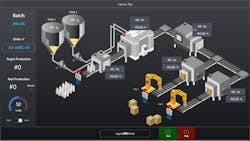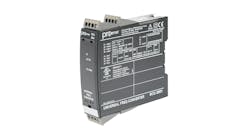When a design team embarks on a new or retrofit project, there are many ways to approach digital monitoring and control. Project technical requirements will generally drive the implementation path toward the desired destination, but there are usually multiple possible routes, and not every course reaches the objective in an ideal manner.
It used to be that a control system designer’s primary digitalization concerns revolved around basic automation and visualization. However, today’s designers must meet current, and often future, needs for extensive industrial internet of things (IIoT) data connectivity by providing intelligent on-site devices, detailed analytics and cloud/remote accessibility (Figure 1).
One might think that achieving so many distinct goals would require a custom assortment of hardware and software products to deliver traditional robust automation functionality combined with modern open connectivity. Indeed, many end users, original equipment manufacturers (OEMs) and systems integrators (SIs) scheme to mix-and-match a variety of elements in an attempt to create a workable system.
A better approach is using proven, pre-engineered solutions to reduce risk, minimize labor and accelerate results. Users can choose the required hardware and software from a portfolio of coordinated products offered by an industry-leading supplier. This empowers them to build reliable, flexible and scalable solutions — with the openness required to work with all types of existing and legacy systems.
Determining requirements
Industrial automation, visualization and accessibility platforms are typically developed from one or more of the following:
- Programmable logic controllers (PLCs) and programmable automation controllers (PACs)
- Edge controllers
- Human-machine interfaces (HMIs)
- Industrial PCs (IPCs)
- Supervisory control and data acquisition (SCADA) systems
Hardware and software making up these systems share basic needs for reliability, capability, connectivity, scalability and security.
For industrial use, reliability is always essential, followed closely by the right functional and performance capabilities. But as users progress from creating small, standalone equipment and instead find themselves developing much more integrated and IIoT-capable systems, improved connectivity and scalability become more important. Ultimately, the need for higher-level networking, computing and interaction with cloud resources drives the demand for comprehensive cybersecurity.
Combining some specialized products with individual capabilities may seem attractive, but this makes it difficult to ensure dependable interoperability. Specific hardware and software may work under certain conditions, but sometimes does not scale up for larger projects, and/or provide acceptable cybersecurity.
Starting from scratch
For IIoT and SCADA initiatives, there is often a temptation to concoct data connectivity from a variety of products, to provide a degree of openness and or capabilities, or for other reasons. But some available options may be built on consumer-grade underpinnings that simply won’t hold up in a 24/7 industrial setting, or technologies that have become dated.
Additionally, certain product offerings may be represented as “unlimited” in terms of licensing, effective tag counts or other aspects, yet implementers may discover that the only way to fully scale up involves increasingly complex configurations. Integration of multiple third-party apps may be hampered by limited or basic communication drivers (and therefore require adding even more third-party products), entail custom scripting/code for implementation and introduce complicated patching and updating maintenance tasks.
Truly pre-tested options are limited, so implementers are tasked with experimenting and developing their own applications to prove out performance and security. SIs with significant automation and programming talent may prefer and be experienced with creating solutions from many individual products. However, this approach makes it more difficult to guarantee performance and supportability, especially when deployed at end users or OEMs who must train limited staff to work on different sets of tools and programming environments for HMI, SCADA, IIoT, edge computing and more.
A comprehensive yet open option
Since a do-it-yourself approach can prove problematic and time consuming, what should users look for when it comes to a more comprehensive platform for creating solutions?
One fundamental from an automation standpoint is that PLCs will continue to remain relevant. However, newer options like edge controllers provide deterministic control combined with the added benefit of general-purpose computing. Therefore, users should look for product families that ensure they can port and deploy existing control logic seamlessly among PLCs and edge controllers without performing rework, using the same toolset for consistency.
Solutions should be scalable from IIoT, to local HMIs to full HMI/SCADA and analytics while providing the ability to create graphics displays in a variety of styles (Figure 2). Once again, users should look for solutions which are built in one development environment, and then deployed seamlessly to any type of end point, whether that is an edge controller, a panel PC or a full IPC.
Users should also investigate the underlying HMI/SCADA structure and ensure it is built on modern standards. For instance, software created using the Microsoft .NET and .NET Core frameworks can be deployed Windows or Linux systems, so it can run on a variety of hardware. Communications architected on OPC UA securely enable a wide range of industrial connectivity. Supporting a full range of client technologies means applications can be deployed on all types of end user devices.
When individual hardware and software items are sourced from a variety of unique vendors, there is a high risk of compatibility issues. On the other hand, a single vendor offering the entire hardware and software portfolio of controllers, PCs and industrial-specific applications is better positioned to ensure compatibility and straightforward integration. Such a vendor can also provide comprehensive libraries of toolbox items and symbols to speed real-world development and integration among PLCs, PACs and HMI/SCADA.
One other advantage of the single-vendor approach is the availability of pre-verified hardware/software platform combinations, not only for delivering functionality but also providing a path for users to meet the IEC 62443-3-3 cybersecurity standard. Ready-to-develop platforms support the most common automation and IIoT tasks such as HMI, edge computing, edge controller, edge analytics and SCADA. Additional modules provide out-of-the-box analytics for common needs like manufacturing performance and energy consumption, so users can apply their efforts toward solving problems, instead of experimenting with the platform (Figure 3).
Application
A company in the food and beverage industry used labor-intensive processes driven by ERP requirements, sending printed instructions to the manufacturing shop floor, where those directions were followed manually, frequently resulting in production or packaging errors. Both rejected and good parts were tallied by hand. The problem is not new, but a flexible approach made the solution achievable in a very short timeframe, without the need for specialized resources to develop the computations and analytics necessary for automating the tasks.
The production manager wanted better visibility but deploying a massive manufacturing execution system was not practical for the company. They instead implemented a scalable solution to collect data from existing data sources, to provide visualization of the production.
As an initial step, this system harvested the most relevant data by first monitoring the product going through the line and identifying good/bad product, and later it was enhanced to transmit work instructions to the floor digitally. A live dashboard provided productivity, overall equipment effectiveness and downtime metrics needed to make the right decisions, and a set of reports helped communicate issues identified during production.
The platform provided timely and accurate data to identify inefficiencies affecting productivity performance and it enabled direct communication to the ERP systems, better positioning the company to improve throughput.
Greater than the sum of the parts
Developers have a lot of hardware and software options for building industrial automation, visualization and data connectivity/analytics projects. However, creating a reliable, scalable, secure and complete solution by starting from scratch and plugging parts together is a risky endeavor. To overcome these risks and minimize overall cost, end users, OEMs and the SIs supporting them should consider the benefits of using comprehensive platforms offered by a solution provider with a complete and coordinated portfolio of industrial-specific hardware and software.
Silvia Gonzalez is the director of product management, software, for Emerson's machine automation solutions business. She is responsible for developing IIoT, industrial automation and controls technologies that bring increased value to customer operations.
Paolo Fiorani is a general manager for Emerson’s machine automation solutions business. He is the co-founder of Progrea, which is part of the Emerson portfolio, and leads this team in developing Movicon SCADA software.
Emerson




